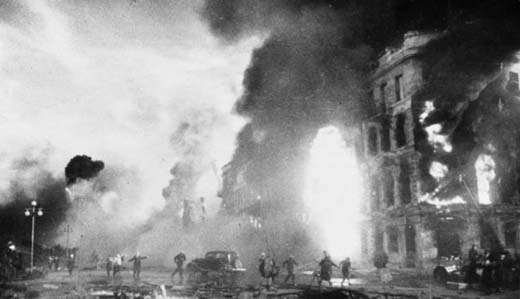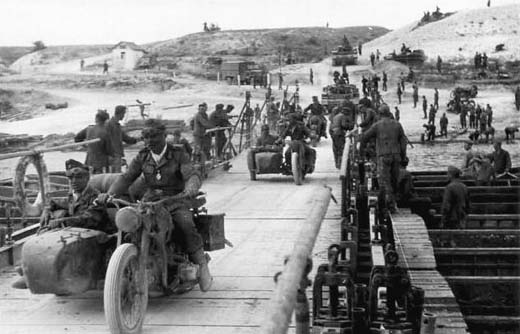Air Operations, Australia
49th Fighter Group P-40s down 7 Japanese Navy bombers and 8 A6M Zeros in the Darwin area between 1205 and 1245 hours.
[Air Operations, Europe
Stalingrad is hit in an all night raid made by 600 bombers, Stukas and Ju-52 bomber/transports. Many crews make up to 3 sorties. Incendiaries start vast conflagrations. About 40,000 people are killed and thousands more flee across the Volga to shelter in caves and sewers.
BOMBER COMMANDDaylight Ops:
- 6 Wellingtons to Bremen on cloud-cover raids, only 2 bomb at Emden; 1 Mosquito to Flensburg
- No losses
Air Operations, Libya
Just before dusk, USAMEAF B-24s attack the harbor at Tobruk.
[Air Operations, Solomons
- 1 5th Air Force B-17 attacks Buka Island.
- A VMF-223 F4F shoots down a G4M 'Betty' bomber over Guadalcanal during a noon-hour attack.
Battle of the Eastern Solomons
Both the Japanese and the Americans send major warships to cover attempts to ferry supplies to Guadalcanal. The main American squadron, Task Force 61, under the command of Adm Frank J. Fletcher, consists of the carriers Saratoga (CV-3), Enterprise (CV-6) and Wasp (CV-7) with a total of 254 aircraft. In support of the carriers are the battleship North Carolina (BB-55), 5 heavy cruisers: Minneapolis (CA-36), New Orleans (CA-32), Portland (CA-33), San Francisco (CA-38) and Salt Lake City (CA-25), 2 light cruisers: Atlanta (CL-51) and San Juan (CL-54), and 18 destroyers.
The Japanese are operating characteristically in several separate groups. Adm Nagumo has the carriers Zuikaku and Shokaku, and Adm Hara has the smaller Ryujo. In support the Japanese have 3 battleships: Mutsu, Hiei and Kirishima, 13 heavy cruisers: Ataqa, Maya, Takao, Myoko, Aguro, Suzuya, Kumano, Chikuma, Tone, Chokai, Aoba, Kinugasa and Furutaka, 3 light cruisers, 1 seaplane transporter, 31 destroyers and 12 submarines. One squadron is escorting 4 transport ships with reinforcements for Guadalcanal. Fletcher sends off a strike but it fails to find any targets. Both forces are now alert for the next day's fight.
[Eastern Front
Army Group B breaks through north of Stalingrad and reaches the Volga on a five-mile front between Rynak and Erzovka. The Soviets continue to resist. 600 Luftwaffe bombers attack Stalingrad, killing 40,000 and destroying three-fourths of the great industrial city. The Russians do not panic and the salient is 'stabilized'. To avoid encirclement, most of the Russians fall back on the city. At Izbushensky, in the great bend of the Don, 600 men of the Italian 'Savoy Cavalry' under the comand of Col Bettoni charge against 2,000 Russians armed with mortars and maching-guns in a last desperate attempt to close a breach opened by the Russians between the German 6th Army and the Italian army. The Italians, in the last cavalry charge in history, put the enemy to flight. Sabers and hand-greanades against mortars and machine-guns - the victory is important locally, but the price is very high.
Bombing of Stalingrad Begins |
 |
(21st?)German mountain troops climb Mount Elbrus in the Caucasus and plant the Nazi flag but it is merely a propaganda victory. In terrain like this everything is on the side of a stubborn defense.
SOUTHERN SECTORThe XIV Panzer Corps crosses the Don River at Vertyachi and races east. By early evening the 16th Panzer Div has reached the Volga River and secured Spartakovka to the north of Stalingrad. Fierce Red Army resistance slows the advance of the rest of the corps, which does not reach the 16th Panzer. A platoon of the 1st Mountain Div hoists the swastika on the summit of Mount Elbrus, the highest peak in the Caucasus.
Germans Cross the Volga |
 |
The Luftwaffe launches a massive air raid against Stalingrad. In total 600 bombers conduct 4,000 sorties over 2 days. Oil storage tanks along the Volga River burst into flame and fires break out in the city. The population numbers 600,000, and up to 40,000 are killed in the raids.[MORE]
[Pacific
- The Japanese occupy Nauru Island.
- The US submarine Skipjack (SS-184) damages the Japanes oiler Hayatomo southwest of Ambon, N.E.I.